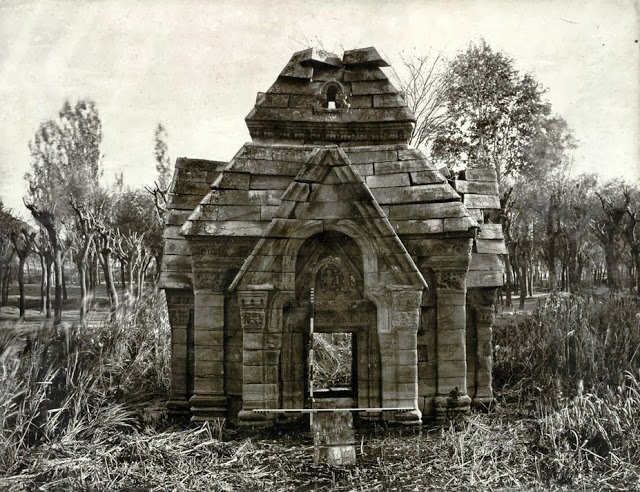Pandrethan is an ancient stone temple dedicated to Lord Shiva that lies within a square shaped tank to the north of Jhelum River.
Shrine’s History
Pandrethan – located 5 km from the present Srinagar. It was the ancient Srinagar established by Asoka Maurya in the 3rd century BC. Asoka was a Hindu then and had not embraced Buddhism then. According to an account, there were 96 lakh houses at that time. It was very populous and prosperous. Asoka’s son Jalauka built the Jyeshta Rudra temple. Around 525, Mihirakula, the Hun king built another Shiva temple there names Mihireswara. About 550, it witnessed further building under Pravarasena .
He constructed a Shiva temple with a circle of Matrikas named Pravaresvara. it seems it was a Yogini temple. He also built more temples in the capital. About 575, Pravarasena II built the new capital named Pravaresvara-pura which is the modern Srinagar. The old city was called Puranaadhisthana – (Pandrethan) that continued to be called loosely Srinagar. in course of time both the cities were integrated and retained the old name Arinaga. in 630, the Chinese pilgrim arrived at Srinagar and was received by the Durlabha-vardahana.
The king provided him with 30 clerks to write his works and five servants to wait on him. Srinagari was a great centre of Buddhist study then. There was a stupa said to have been built over a tooth relic of Buddha. Around 920 Meruvardhana, a minister to the king built in Purana-adhisthana, a Vishnu temple named Meruvardhana Swami. In 1130, Rilhana, minister to King Jayasimha embellished both the old and new cities.
He also built a Siva temple in the old city by name Rilhanesvara. The Pandrethan became a centre of all important religions like Saivism, Buddhism, Vaishnavism and Sakthi. Around 1400 the Sultan Sikandhar started destroying the temples and images and earned the name idol breaker (Butshikan). He destroyed almost all the temples of the country. The images were mutilated and thrown. This was achieved by heaping timber over the temples and setting them on fire. Records say Brahmins were tortured and the temples ruthlessly destroyed.
The images of Vijayesa, Chakradhara, Martanda, Birhad Buddha, Suresvari and Varaha were also destroyed by him. Those times the central image used to be made of metal – gold, silver or brass. All these images were mutilated and melted down for Sikandhar to issue his coins. Abu Fasl also wrote about Sikandar’s zeal in destroying religious foundations other than his own. Western scholars found in the 19th-century enormous number of mutilated sculptures and Lingas lying among the heaps of temples.
Alexander Cunningham found a large number of destroyed sculpture etc from the Sankaracharya Hill for about 5 kilometres. The sculptures found are noted in the Pratap Singh Museum. The only ancient vestige in Pandrethan is a Siva temple surrounded by a water of a tank. Though it is in ruined condition, it shows the ancient trend in building temples in Srinagar. It is dated to an age earlier than 10th cent.
It is a square temple with a pyramidal roof. There are some sculptures, one representing Lakulisa with a Lakuda (Shaft) in hand. The ceiling inside has lovely carvings. It is an important temple that needs to be visited in the old Srinagari / Pandrethan.” Contributed by guest author Subramanian. The Kanchi mutt calendar 2016 lists this as the Adhishtanam of the 16 the Guru of the Kanchi Kamakoti peetam SRI UJJWALASHANKARENDRA SARASWATHI 329-367 AD
Architectural Relevance of This Shrine
The famous stone ceiling of this temple has elaborately carved bas-relief figures and boasts of some of the most perfect and popular pieces of ancient carvings existing in Kashmir. Its pyramidal shaped roof is partitioned into two areas by an ornamental band. Carved capitals surmount its corner pilasters and melon-shaped ornaments add the edges to the pediments of its porches. The ceiling is carved out of nine large blocks of stone; with four of them resting over the angles of its cornice and reducing the opening to a small square. The upper part of these stones is accurately covered by a large lotus and reduces the opening even further.

By Road
There is a well-connected service from Jammu to Srinagar which takes around 10 hours from Jammu to Srinagar.
By Rail
Srinagar Railway Station is just 3.2 Km away from the Temple.
By Air
Srinagar International Airport is just 11 Km away from the Temple.
Extra Information About this Shrine
Now the area of Army Cantonment and inside one of the army compounds. It is being protected by the Indian Army due to its historical significance and they maintain it. Naturally, prior written permission is required before one is allowed in













































